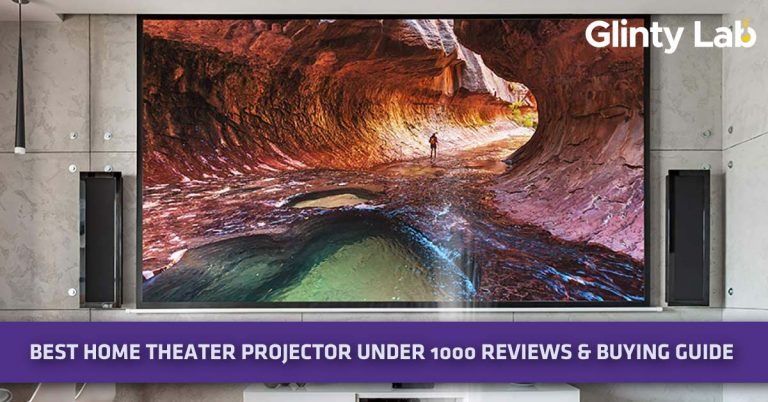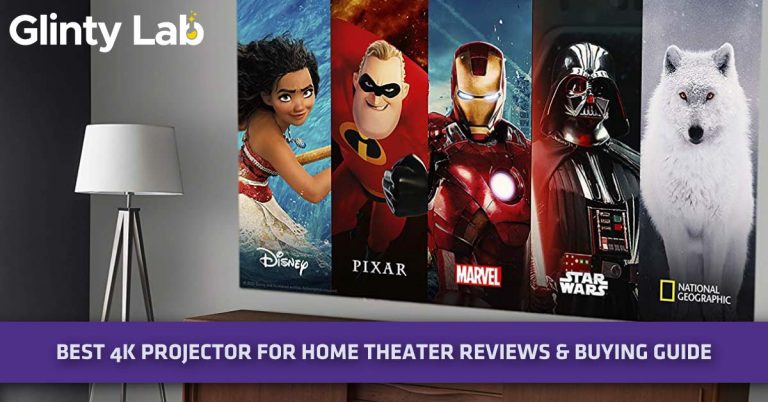Best Home Theater Projector Reviews 2024 – Top 8 of Current Market
Finding the best home theater projector in the modern era that has excellent b and stunning gaming experience with decent lumens, which can project high-quality images with deep blacks, accurate colors, realistic and natural skin tones, and sharpness with 1080p or 4K resolution without rainbow effect is a bit difficult process due to already saturated market.
Other specs like its size and shape, multi-media connections, whether the home projector is DLP, 3LCD, or LCOS based, zoom lenses, vertical and horizontal lens shift, throw range, and low input and refresh rate for gaming should also be considered in the best projector before making a purchasing decision.
After testing several home cinema projectors, and interviewing users offline and online, we have considered color accuracy, black levels, throw range, contrast ratio, sharpness, resolution, type of lighting source, type of movie projector, brightness, and visibility in the presence of ambient light.
We have also covered some of the top budget home theater projectors, and 1080p units that use pixel-shifting technology to enhance the resolution at an affordable price.
Before getting on to our list, check out the top 3 home projector picks.
★★★★★
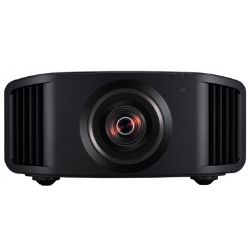
- TRUE 4K
- Fantastic HDR Handling
- Stunning Blacks
★★★★★
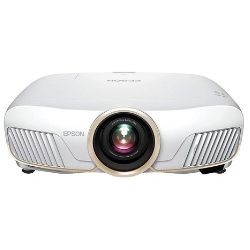
- Cinematic Performance
- Excellent Picture Quality
- 7.1 smart android system
★★★★★
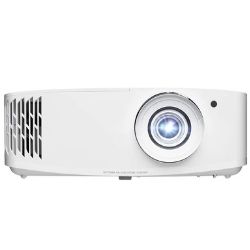
- Low input lag.
- 3400 ANSI lumens
- Ultra-Gaming experience
Best Home Theater Projector
According to our research, the best home theater projector is one that offers excellent color accuracy with natural skin tones, high brightness, deep blacks, sharpness, keystone correction, high contrast ratio, true 4K, or 1080p resolution with fantastic picture quality, ultra-HDR performance, and low input lag for gaming.
You can easily get a quality home projector with all the features mentioned above at a very affordable price. We have also added such budget-friendly home video projectors to our list.
We have also included the best projectors with true 4K resolution, loaded with features and stunning HDR performance if your pocket permits you.
Check out our top 9 list before we get into the individual reviews.
List of the Best Home Theater Projector of 2022
| IMAGE | PRODUCT | DETAILS | |
|---|---|---|---|
|
EDITOR’S CHOICE
|
JVC DLA-NX5 4K D-ILA Projector |
|
CHECK PRICE |
|
BEST FOR GAMING
|
Optoma UHD50X True 4K UHD Projector |
|
CHECK PRICE |
|
LATEST WebOS
|
LG HU70LA 4K UHD Smart Home |
|
CHECK PRICE |
|
BEST UNDER $5K
|
Sony Home Theater Projector VPL-VW295ES |
|
CHECK PRICE |
|
BEST UNDER $1500
|
BenQ HT3550 4K Home Theater Projector |
|
CHECK PRICE |
|
BEST SDR
|
BenQ HT5550 True 4K UHD Home Theater Projector |
|
CHECK PRICE |
|
BEST FOR GAMING
|
Epson Home Cinema 5050UB 4K PRO-UHD |
|
CHECK PRICE |
|
HIGH-END
|
JVC DLA-NX9 4K Home Theater Projector |
|
CHECK PRICE |
1. JVC DLA-NX5 4K D-ILA Home Theater Projector
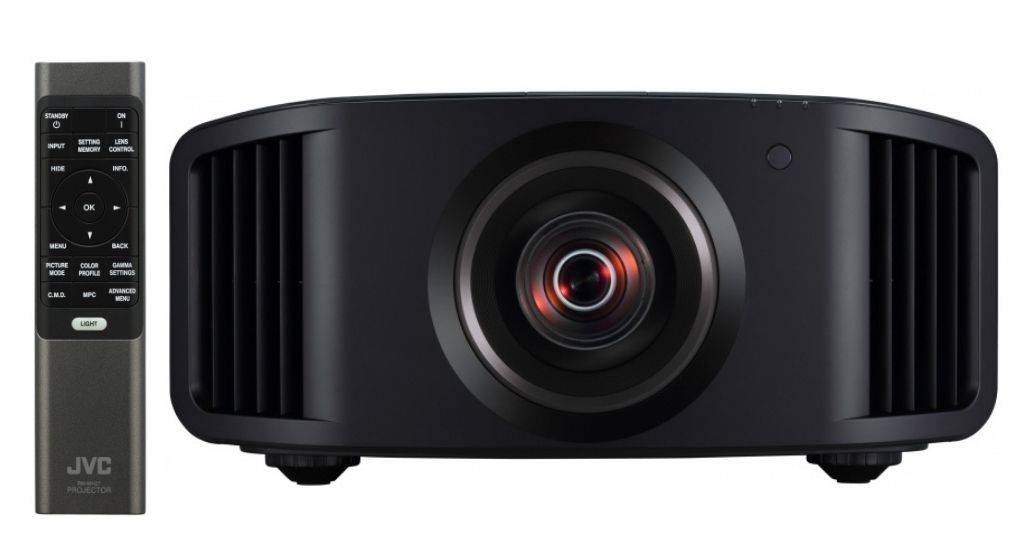
- Extremely durable with crystal clear projection
- Inputs: HDMI 2 (x2) | two 18GBps compatible inputs
- Outputs: RS232C (D-sub 9pin) x 1 LAN (RJ-45) x1. Mini Jack. 3D Syn.
- 3D Mode: Yes.
- 65mm ultra-quality glass lens
- HDR10 compatibility
- True native 4K
- All glass lens
- Spectacular HDR handling
- Display Type: 2 cm D-ILA x 3
- Lens: Manual Zoom (x2). Power Focus.
- Lens shift: +/-80% Vertical. +/-34% Horizontal.
- Item weight: 45 pounds
- Mounting Type: Table top
- Dimensions: 25.25 x 26.25 x 16.38
- Model number: DLA-NX5
- Display Resolution: 4096 x 2160 (True 4K)
- Native contrast ratio for deep blacks: 40,000:1
- Dynamic contrast ratio: 400,000:1
- Lamp: NSH 265W Lamp
- Lamp life: 3500 – 5000 hours (eco/normal)
JVC DLA-NX5 Home Projector Review
JVC DLA-NX5 is a massive, all-glass lens, native 4k home projector with the new frame adapt HDR in the auto-tone mapping is its biggest selling feature.
JVC’s D-ILA models are some of the best home theater projectors in the market. They offer brilliant contrast handling, smooth black levels and color bending, and a true 4K display.
Sitting below the NX7, and the flagship N9, JVC DLA-NX5 is the entry-level 4K projector that is using the same 0.69 inches of native 4k D-ILA device as the higher model.
Why choose JVC DLA-NX5 Home cinema 4K video projector
- NX5’s resolution is 4096 x 2160. True 4K display.
- It has a 17 element, 15 grouped all-glass lenses with a 65mm diameter to project flawless 4k resolution which covers all corners of the screen.
- This model claims to have a brightness of 1700 – 1800 lumens and has a native contrast of 40,000:1 with a dynamic contrast ratio: of 400,000:1.
- This video projector has a fully motorized lens shift with control over zoom and shift.
- This works with the new installation modes that allow you to have preset control over a lot of settings including aspect ratio masking.
- This best home projector opens up a lot of possibilities to have various modes for different viewing experiences of the content.
- The HDR10 which is compatible with the auto-tone mapping significantly improves HDR playback of the movie projector to balance the image while retaining the tiny details, highlights, and shadows.
JVC DLA-NX5’s Design
This model is using the same casing as NX7 which is pretty much big and tall.
The design is more of an old school with a centralized lens and exhaust and air vents to each side of the front. The finishing is extremely smooth.
The lens opening is 65mm in diameter, and 7 inches wide. There are three indicator lights at the top right. There is a couple of logon on the top as well.
It is available in two colors. Black and white. I prefer black, it matches the theme of my room. Personal preference.
Connections and Controls
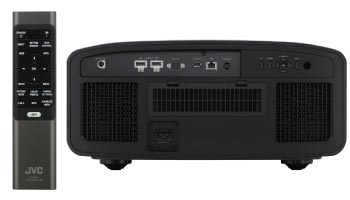
- The 3D sync input.
- and two HDMI (x2) inputs with HDCP 2.2 compliance are the top let.
- It will accept full 18GBps transmission band-width (4K60p 4: 4: 4, 4K60p 4: 2: 2/36-bit, 4K24p 4: 4: 4/36-bit)
- There is an RS-232-C control port
- USB service port.
- LAN Ethernet.
- 12-volt trigger.
If you are a clumsy guy like me and happen to misplace the remote control, there is a control panel with manual buttons at the backplate.
JVC DLA-NX5 comes with the latest N-series remote controls that are easy to use. It is also backlit which helps a lot in the bat cave environment to operate the projector.
Overall performance of the JVC DLA-NX5
When used in a bat cave environment, JVC DLA-NX5 performs at its true capacity with excellent black levels and decent image details.
A high-quality lens is being used which enables excellent image sharpness that is uniform across the screen. Upscaling and video processing are also fantastic with nice sharp edges without any unwanted ringing.
JVC DLA-NX5 is one of the best home theater projectors so you should expect solid dynamics, stunning blacks, and excellent shadow details adding depth to the image quality.
Colors are also amazing with realistic skin tone giving this model a cinematic edge over most of the home cinema projectors in the market.
JVC DLA-NX5 doesn’t include the wide color gamut filter unlike upper models (N7, N9). Thanks to the dynamic tone mapping, JVC has now the most convincing HDR images on this best projector.
With mid-tone shadows and deep blacks, it adds depth and texture to the HDR images with very realistic and visible details.
- Deep blacks
- True Native 4K display
- Excellent shadow details
- Flawless HDR handling
- 65mm high-quality glass lens is being used
- Comes in warranty
- Easy to use
- Realistic color tones
- Very durable
- High contrast, ultra-bright
- Gives excellent value for money.
- For 3D, it requires an add-on
Final Verdict
At this price tag, it manages to produce some of the best HDR10 images despite not having the white color gamut filter as NX7 and NX9. The frame adapts dynamic tone mapping has been the major selling point for JVC models.
With the price point, try and find some negatives in this machine, I am sure you want any. 9/10 from me.
2. Optoma UHD50X True 4K UHD Projector for Movies and GamingÂ

- Ultra-Gaming experience with low input lag
- Easy installation
- HDR10 and HLG support
- Crispier and colorful picture
- Very bright picture
- Eye strain reduction through reflected light
- Loaded with connectivity
- Deep blacks & high dynamic range for brighter whites
- Resolution: 3840 x 2160
- Product dimensions: 4.6 x 12.4 x 10.6 inches
- Item weight: 8.6 pounds
- True 4K ultra-HD
- 3400 ANSI lumens
- 15,000 hours lamp life
- 24 Hz refresh rate at 1080p
- Contrast ratio: 500,000: 1
- 1.3x zoom, vertical lens shift.
- Standard throw: 120†image from 10.5 – 13.9 ft. away.
Optoma UHD50X Home theater projector Review
Optoma 1080p HDR was probably the best 4Kgaming projector with low input lag and color brightness, and unfortunately, most of the high-end 4K projectors didn’t have great input lag, so hardcore gamers like me were stuck at 1080p back in the day.
But,
Optoma UHD50X changed that with its certified 4K UHD projection, extremely low input lag, 240 Hz refresh rate, and fantastic color brightness.
Compared to the UHD50, Optoma UHD50X is way brighter, has better HDR performance with HLG support, instead of 6, it has an 8-segment color wheel, and it also has the newer DLP 4K chip which means it will not have the light border issues as UHD50 had.
Why choose Optoma UHD50X Home theater projector
- It produces 3400 lumens which means it is bright.
- This unit has an input lag of 24 milliseconds on 4K with enhanced gaming mode enabled. It can also get down to 16 milliseconds with full HD at 240 hertz.
- Optoma UHD50X has a great throw ratio allowing you to project 120-inch images from 9 – 14 ft. away.
- It has also an eight-wheel color segment.
- Not only it does have input lag, but you will be impressed by its 4K HDR performance.
- Most projectors in this price tag don’t display certain shades of yellow and orange accurately, but I am impressed by its color accuracy.
- Images are nice and sharp and you will have no issues getting the image focus in seconds which has been a challenge in most 4K home projectors.
- HDR tone mapping and color accuracy are also very good for such a bright projector. Optoma projectors are famous for their color brightness whereas other DLP projectors struggle a lot.
- It reflects the light to reduce the eye strain which is great considering how harsh direct light can be.
- Place it on a table or shelf, and it is ceiling mountable as well.
Design of Optoma UHD50X Gaming projector
This unit is pretty compact and lightweight coming in just under 9 pounds. The white body is smooth and beautiful.
All the buttons and controls are on the top including the lens shift and zoom lights. The focus dial is position around the lens. Air vents are huge so that it remains cool during the 4K projection. I believe it is one of the most beautiful home theater projectors in the market. Just my opinion.
Connectivity and controls of Optoma UHD50X
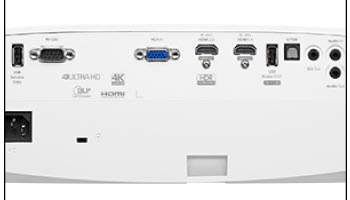
- A USB service port
- RS-232C port
- A VGA port
- A 12-volt trigger
- HDMI 2.0 port for 4K HDR content
- An HDMI 1.4a port for non-HDR content
- S/PDIF optical audio out
- 5mm audio in and out
The remote is small, white, and backlit. It fits nicely in the hand. Buttons are a bit small but you can run the entire menu through the remote. A quality remote control overall.
Performance of Optoma UHD50X home theater projector
If you are planning on buying this projector only for movies, it is very good but doesn’t expect a very color accuracy since this model is levitating towards brightness rather than color accuracy.
But that doesn’t change the fact that Optoma UHD50X would work very well in a room with some ambient light as long as the screen is not huge.
Shadow details are good, but black levels are not perfect because it is a 3400-lumen projector.
Even without the deep black levels, I have not heard complaints because the image quality is excellent for movies.
It doesn’t offer motion smoothing which is not a big deal because most movies don’t look after motion smoothing.
You can turn on the dynamic black (OFF by default) which will dark scenes impressive and black levels deep. With dynamic black OFF, the black levels could be a little muddy and uneven. You will notice this difference.
The projection of Optoma UHD50X is extremely bright even with 2 – 3 fluorescent tubes ON.
The image is clear and sharper. You can play with the color settings according to your taste to make it more accurate.
Overall, it is indeed a true 4K projector with stunning projection performance for gamers, and decent image quality for movies as well considering the price tag.
- Low input lag
- Extremely good brightness
- Best 4K gaming projector
- 240-hertz refresh rate
- True 4K resolution
- Very good HDR performance
- Compact and lightweight
- High value for money
- Easy to use
- Color accuracy is not that great
Final Verdict
Overall Optoma UHD50X is targeted at the gamer community that was desperately needed due to the lack of projector target in the gaming industry.
I am not afraid to say that Optoma UHD50X is the best home theater projector for gaming.
3. LG HU70LA 4K UHD Smart Projector
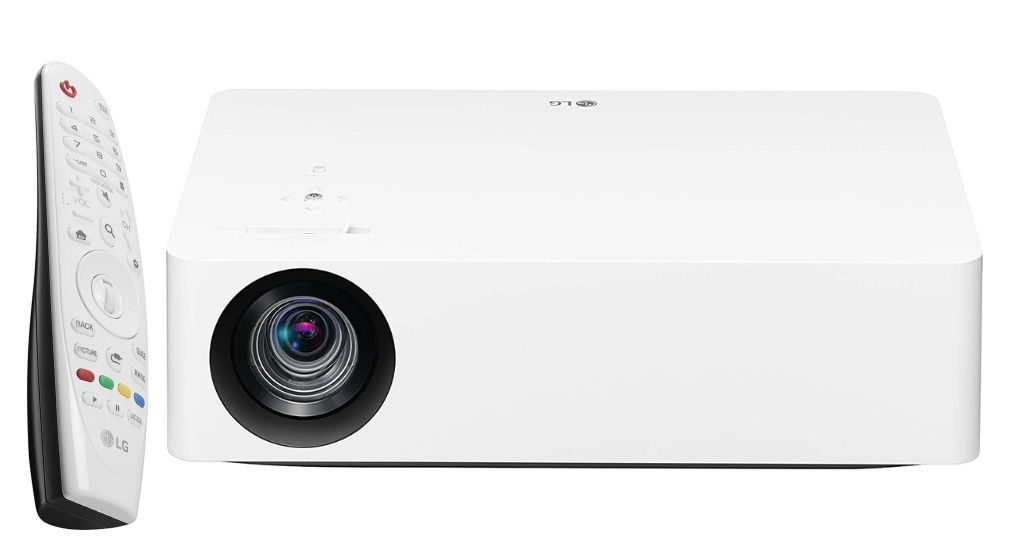
- Sleep and lightweight
- Digital TV tuner
- LG smart TV platform
- 5 color presets for HDR & 8 for SDR
- DLP technology
- Fantastic Image quality
- Built-in streaming services
- Better color accuracy
- 90% less rainbow effect (Which is good)
- 1500 lumen
- Item weight: 7.1 pounds
- Dimensions: 8.2 x 12.4 x 3.7 inches
- 2 AAA batteries required
- 4K UHD resolution: 3840 x 2160
- LG WebOS Lite.
- HDR10+trumotion
- LED projector with 30,000 hours life
LG HU70LA LED projector Review
At a very budget-friendly price, the LG HU70LA LED projector is offering an LED-based engine with more than 30,000 hours of life. Flawless image quality, 4K display, better color accuracy, and HDR10 with TruMotion.
This is the first 4K LG movie projector with a price under $2k. There are some built-in streaming services like Netflix and Fandango which are kinda new.
Like most high-end home cinema projectors under $5k, LG HU70LA uses pixel shifting to display a stunning 4K image using a 0.47 DLP chip.
It is a legit 4K LED home projector with awesome picture quality.
Why choose the LG HU70LA home movie projector
- It stands out from other models because of its There is no need to purchase separate streaming because it works well.
- You will be able to steam 4K movies. You can even mirror your phone screen.
- LED projectors are not that bright usually, but the image quality and color accuracy are impressive on this model.
- With the lights off, you will get a stunning 4K resolution on a 135†screen.
- HDR mode does a very good job of maintaining brightness with HDR content with incredible color accuracy and tone mapping.
- LG HU70LA LED projector can easily rival high-end HDR units.
- So the black levels are not the best, but color accuracy makes up for it. You won’t feel any bug while watching in HDR mode in a dark room.
- As long as you are not a hardcore competitive gamer, this projector is not a bad choice at all.
- Instead of using a spinning color wheel, LG HU70LA is using a static color filter to eliminate 90% of the rainbow effect. That is a very good improvement.
- This one is a lightweight model that is easy to carry around. It is both, wall and tabletop mounted.
Design of LG HU70LA home movie projector
The design is minimalist with few buttons on the top including a zoom dial, directional button, and focus button.
It is super lightweight, sleek, and compact. Probably the most beautiful 4K film projector under $2k.
It can be table-mounted or ceiling mounted. LG HU70LA has vents too despite being an LED film projector that rarely gets hot.
Connections and control of LG HU70LA
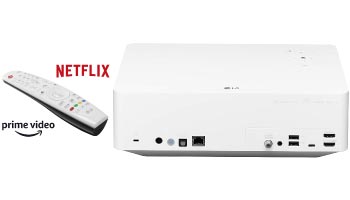
- 2 HDMI inputs
- USB inputs
- Digital TV tuner to connect your internet
- LAN Ethernet port
- A fiber optic output
- Standard 3.5mm jack
- Built-in Bluetooth
- Built-in speakers. You can use fiber optic or Bluetooth to connect to the speakers.
- Automatic Keystone correction
- 60†– 140†screen size
- No 3D support.
Performance of LG HU70LA UHD
LG HU70LA is a quiet projector. Even if you hang it above your head, you will not hear a thing so kudos to LG.
It is a very bright projector despite 1500 lumens. With decent ambient light, you will get an extremely good image, but by shutting the ambient light down, you will get blown away by the picture quality.
Being an LED projector it is not going to have the best black levels, and it is rated at 1500 lumens so you should avoid the rooms where ambient light is dominant.
Between 100 – and 120 feet is the sweet spot. You will get optimum brightness at this range.
Overall its performance is extremely good in a dimmed lit environment. It will give you 4K resolution and its HDR is mind-blowing considering the price tag.
- Excellent 4K resolution
- HDR mode is also fantastic
- Budget-friendly
- LED engine with 30,000 hours of life
- DLP machine
- LG WebOS.
- Noiseless
- Color accuracy and brightness levels are stunning
- Excellent for gaming too.
- Black and accuracy get better on Blu-ray
- Google Assistant onboard
- No 3d
- Blacks aren’t that good.
Final Verdict
There are so many things you can do with this best projector like a built-in speaker if you want to watch something quick and don’t have an external source.
Smart TV features built-in, decent connectivity on the back, you can plug in your cellphone on the back, and it is easy to move around and set up quickly.
Overall, the LG HU70LA home cinema projector is of great value. 8/10 from me.
4. Sony VPL VW295ES/VW270ES Home Theater/HD Projector
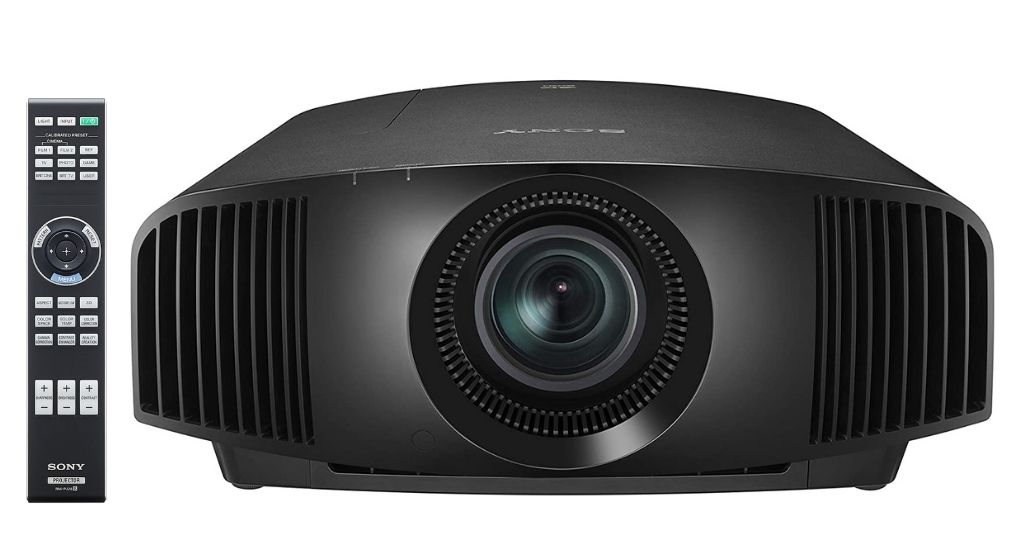
- HD 3D playback
- Motion flow technology
- Stunning IMAX visuals.
- Bright highlights and excellent deep blacks
- Super-resolution 4K upscale for image enhancing
- HDR reference mode to retain the creator’s intent
- HDR10/HLG compatibility
- Input lag reduction for stunning 4K gaming
- Wide lens compatibility
- 225-watt high-pressure lamp lasts up to 6000 hours.
- 1500 lumens
- Item weight: 37.5 pounds
- Dimensions: 18.2 x 19.5 x 8 inches
- Resolution: Full 4K (4096 x 2160)
- HDR compatible
- Lens shift: Vertical: +80%, -85%. Horizontal: +/-31%
- Low latency game mode.
Sony VPL VW295ES Video Projector Review
Sony VPL VW295ES is an SXRD lamp-based home theater projector with a true 4K resolution of 4096 x 2160 pixels.
It is beautifully designed, has a motorized lens, can play full HD 3D, and is certified for IMAX enhanced content.
Perhaps the best home theater projector under $5k. Back when it launched, it was the most affordable projector in the market considering the features it provides.
The biggest improvement in this best projector is that now motion flow can be deployed in 4K content so that you can watch fast-action sports and spots. While we are at it, our best 4k projectors guide might help you to choose high-end projectors if you can afford them.
Why choose the Sony VPL VW295ES home theater projector
- This offers a true 4K resolution up to a massive 300-inch maximum screen size.
- Like most Sony models, VPL VW295ES/VW270ES calibrates beautifully. It means all color tons including skin tone will look extremely natural and realistic in real-life content.
- Sony has also improved gamma tracking on this model with 2.4 gammas in a linear fashion. It means more shadow detail compared to VW260 which means a more immersive cinematic experience whatever content you watch.
- Blacks are really good. They are not as fantastic as Sony’s upper models with dynamic Iris.
- But, the absence of dynamic Iris on VPL VW295ES means that there is no fluctuation in luminance or light pumping artifacts.
- Motion handling is fantastic delivering smoke pans in 24 frames/sec eliminating judder. Motion flow frame interpolation is for both 1080p and 4K signals.
- It also supports full HD 3D which is kinda cool too for a decently priced model.
- The lens quality and optical performance are satisfactory considering the price point.
- This model is extremely affordable and was named the most affordable home HD projector with a 5-star rating when it a couple of months after its launch.
- The powered lens adjustments will help you to provide very fine control of focus.
- VPL VW295ES/VW270ES supports open standard HDR10 and broadcast-friendly HLG formats. You may wanna leave HDR settings to auto for better image quality.
- The HDR mode is not bad for an HD projector under $5k. The black levels, color saturation, skin tones, and brightness is spectacular in a dimmed lite environment.
Design of Sony VPL VW295ES home theater 4K projector
VPL VW295ES/VW270ES carries that same beautiful design that Sony has been using for quite some time now. There are virtually no flaws in the design and it is super easy to carry.
A centrally mounted lens flanked by air vents at the front plate with a matte black finish. It is also available in white. IR sensors are on the front and back.
Lens shift, zoom, and focus can be adjusted electronically with precision which is appreciated. The lens cover is not motorized though.
Button, menu, and power input are on the side.
Connection and controls
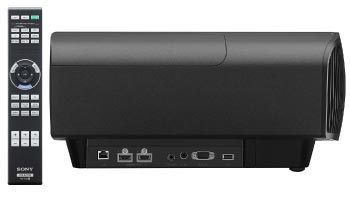
- 2 HDMI 2.0b ports with HDCP 2.2 compliant
- 1 USB type A
- 1 IR In
- LAN Ethernet port
- RS-232-C port
- 12-volt trigger
Performance of VPL VW295ES Home projector
VPL VW295ES shows a beautiful cinematic picture. The details of true 4K resolution, remarkable color accuracy after calibration, flat 2.4 gamma tracking with greater pop and shadow detail are its main selling points.
It has outstanding motion handing. Like other Sony HD projectors, this one is also compatible with IMAX enhanced content for more stunning visuals.
Sony VPL VW295ES uses three LCoS SXRD imagers to deliver equal white and color brightness.
Its brightness uniformity is rated at 78.1% which is kinda average. Sharpness is very good from edge to edge.
It is fantastic for gaming too because it is been equipped with input lag reduction settings to optimize the gaming experience
Overall, I would say it is the best home theater projector under the $5000 price tag in terms of performance
- A stunning 4K display
- Motion frame interpolation for 4K and 1080p
- Input lag reduction to optimize the gaming experience
- The IMAX content enhance is great for better and bigger visuals
- HDR10 and HDR reference mode
- Good lamp life
- A motorized lens with powered zoom
- Free from rainbow artifacts
- Reality creation for 4K
- Nine preset picture/ color modes
- No dynamic IRIS to enhance black levels.
- 1500 lumens are not enough in high ambient light presence.
Final Verdict
VPL VW295ES/VW270ES is the best home theater projector in terms of native 4K affordability.
With its full calibration controls, motorized lens features, 3D capability, excellent SDR and decent HDR results in the price point, low input lag for gaming, fantastic color saturation, and realistic skin tones, VPL VW295ES/VW270ES is a highly recommend home cinema projector under $5k.
9/10 from me.
5. BenQ HT3550/W2700 4K Home Theater Projector
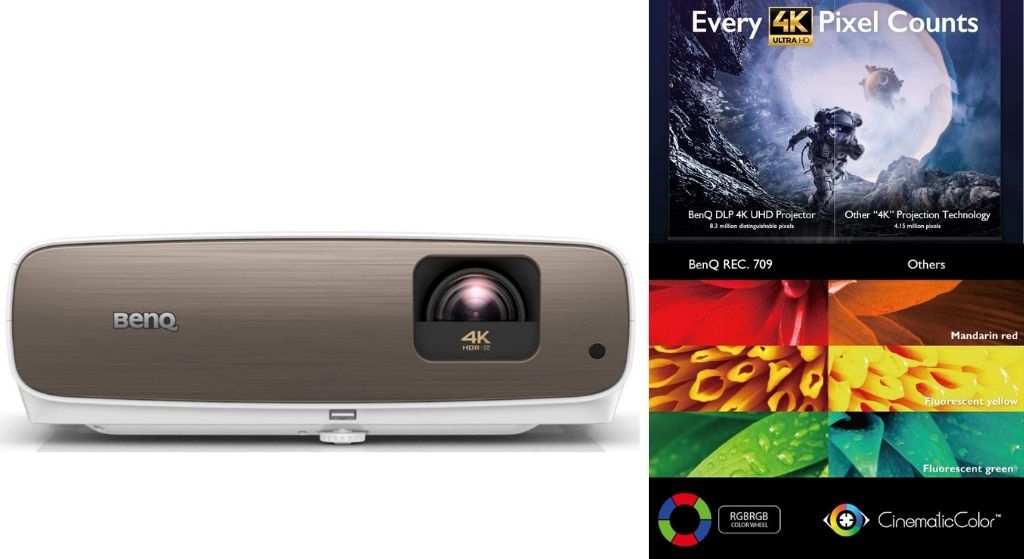
- Full HD 3D mode
- HDR-pro tone mapping
- Dynamic Iris for enhanced darker contrast
- Stereo sound system
- HDR10 and HLG
- Very good color details and realistic skin tones
- Manual Zoom lens – Short throw
- Projection optimization by HDR brightness
- Auto Vertical Keystone
- IFccc certified
- Product Dimensions: 14.96 x 5 x 10.35 inches
- Item weight: 9.2 pounds
- 4K UHD resolution (3840 x 2160)
- DLP machine
- 245 watt lamp
- Lamp life: 4000/10000/15,000 normal/eco/smart eco
- Lens shift: Vertical up to +10%
- Contrast ratio (FOFO): 30,000: 1
- 10 element, 8 group, all glass lens.
- Cinematic Colortech attains 95% DCI-P3 color space
BenQ HT3550/W2700 4k Home Projector Review
This model is in between HT2550 and HT5550 and is specifically designed to handle the 4K content with HDR. It comes at a significantly lower cost than a native 4K chip.
BenQ HT3550/W2700 is a DLP, 4K home theater projector that has the latest 0.4 inch DMD chip which uses a quadruple flash to trick the eye into seeing an 8.4 million pixel image on the screen.
They have added new features to this model lie dynamic IRIS, improved tone mapping to assist HDR image reproduction, a 6-segment (RGBRGB) color wheel that boasts a 100% REC.709 coverage, and 95% white color gamut DCI-P3 coverage with the use of a filter.
Why choose BenQ HT3550/W2700 home theater 4K projector
- This unit supports HDR10 and HLG standards in terms of dynamic range.
- It also has a 4k motion enhancer mode that adds interpolation which is switched off by default.
- You will see the content as it’s intended with 24 frames per second.
- In the accurate movies modes, most of the unnecessary features are switched off by default
- At this price point, nobody is going to get the video projector professionally calibrated, but BenQ Projector has done extremely well and the user will benefit from some reasonably good image quality out of the box.
- The white color gamut is noticeable and tone mapping does allow for a consistent high-quality image to be displayed.
- With Rec.709 coverage, films look cinematic and highly watchable considering their price point.
- The lens is high-precision 10 elements, 8 group array that provides a sharp image that retains sharpness across the lens and image face with no soft corners being visible, and no obvious visible issues with chromatic aberration when setup accurately.
Design of BenQ HT3550/W2700
It has that classical body design with a lens position to the right. A square opening with a lens cover, and a straight edge cover to the bottom.
Above the lens, the sliding door will reveal lens shift, focus, and manual zoom controls. There are built-in speakers behind the grill.
The overall design is neat and smooth. This film projector is easy to carry around and it is ceiling mounted.
Controls are connections of the BenQ Projector HT3550/W2700
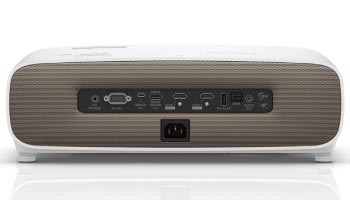
All the connections are in the center.
- Analog and digital audio outputs
- A USB port for power
- 2 HDMI 2.0b ports (with HDCP 2.2 compliance) that can support 4K60p signals with HDR10 and HLG.
- 1 USB 3.0 port with media player capabilities
- A mini USB port for service
- RS-232-C port
- A 12-volt trigger.
Remote control and neat, clean, and easy to use. It is backlit for use in the dark.
Performance of BenQ HT3550/W2700Â projector
With normal HD and 4K content using the Rec.709 color, its performance is excellent in dark rooms with little ambient light.
HDR results on a projector will never get closed to the TV’s HDR results. Even 4K projectors above $10k struggle to produce accurate HDR content.
BenQ HT3550/W2700 is not the brightest of projectors out there. HDR playback is especially true with the filter being used but doesn’t affect its performance.
This BenQ Projector provides fantastic cinematic images for a budget-friendly projector.
Black levels are also acceptable, and there is a little shadow detail to be seen on the lower edges of the image.
Image brightness is very good for dark surroundings which allow this cinema projector to display a colored and textured image that is sharp, and detailed.
With SDR, BenQ HT3550/W2700 is very much capable of nice image accuracy with greyscale and color reproduction added to the image sharpness, and good 24 frames/sec: pulldown for motion.
- Supports both HDR and HLG
- 4K UHD (3840 x 2160) resolution
- 0.47 DLP chip to reduce dark frame around the image
- Director envisioned cinematic color
- Factory calibrated
- And the color and tone mapping
- 4k motion enhancer mode
- Acceptable black levels considering the price tag
- 3D mode
- 100% Rec.709 coverage, 96% DCI-P3 coverage
- Too much input lag for hardcore gamers.
Final Verdict
When set up correctly while ditching some of the HDR features like the white color gamut filter, you will be experiencing some serious cinematic experience for the money.
With the fantastic image sharpness, fair motion with 24 frames per second, good color, and greyscale accuracy, BenQ HT3550 is the best home projector under $2000 and deserves 9/10 from us.
6. BenQ HT5550 True 4K UHD Home Theater Projector
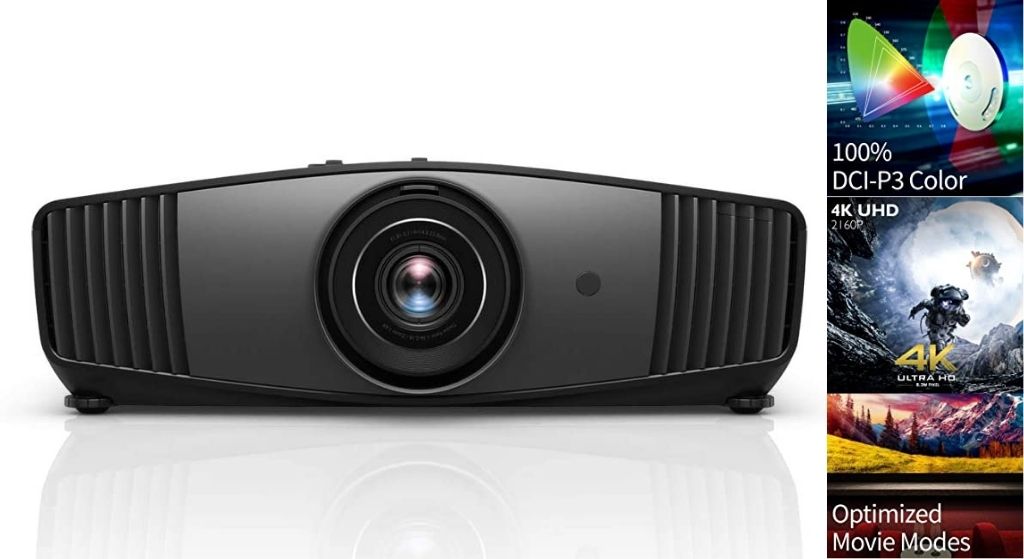
- Compact design.
- A 3-year warranty.
- 100% DCI-P3 cinematic color.
- 8.3 million Pixel perfection.
- Impressive black levels.
- ISFccc certified.
- Brightness projection optimized by HDR.
- Optimized movie mode.
- Item weight: 14.3 pounds
- Display resolution: 3840 x 2160. True 4K UHD
- Contrast ration: 100,000: 1
- Lamp life: 4000+ hours
- 1800 ANSI Lumens
- 2D lens shift with 1.6x big zoom
HDR-PRO
BenQ HT5550/W5700 Home Projector Review
BenQ HT5550/W5700 is a beautifully designed, ISFccc certified, and budget-friendly home projector that is best suited for dimly lit cinema rooms providing a better cinematic experience than other 4K DLP projectors.
It uses the latest 0.47-inch single-DMD from the Texas instruments. This uses a quadruple flash or pixel shift that tricks the eyes to witness 8.3 million Pixels on the screen.
By using this technique, it can give you a high-quality 4K resolution screen at an extremely low price tag than a Native 4K chip.
Why choose BenQ HT5550/W5700 home projector
- This BenQ Projector is an excellent single-chip DLP video projector that is designed for the home cinema experience.
- It produces SDR images at a pinpoint accuracy which is a great achievement for a DLP machine.
- With HDR, BenQ Projector works at its best with a sharp and detailed image that has very realistic colors, skin tones, decent black levels, and image dynamics.
- Motion is very good which another benefit of DLP machines is. It adds 24 frames per second.
- The frame interpolation system is for sports and fast-moving content, but smoothing could be distracting for film content. I switch it off during movie time.
- BenQ HT5550/W5700 delivers high-quality 4K resolution at a very budget-friendly price which is another reason to purchase it.
- This best projector gives a tough time to its smaller brother BenQ 2700 in terms of performance.
- It is also 3D capable with excellent motion.
- This model is highly budget-friendly considering the image quality, and 4K resolution capability.
Design of the BenQ Projector HT5550/W5700
The design is very beautiful and more focused on the home cinema design pattern. It is significantly larger than other BenQ home cinema projectors in this price tag.
There is no built-in sound system, and it is a tabletop mounting type or ceiling mounting type.
There are lens control dials at the top plate and a focus and zoom dial on the lens itself.
The air intakes and exhausts are to the opposite sides of the front plate.
HDR Results:
- BenQ HT5550/W5700 is a budget-friendly home projector, so it is important to manage your expectation when it comes to HDR images.
- At this price point, it is difficult to maintain get enough brightness to add dynamic range impact which you will get from an OLED or LCD TV screen.
- This BenQ Projector is perfect when it comes to HDR results in the price tag, but when used in a dedicated cinema room with no ambient light, you will get a stunning HDR result.
- Although, uniformity struggles a bit, and far edges are a bit blurry, but nothing significant.
Lens:
The lens is super high resolution, 11 elements, 6 groups that provide sharp 4K images across the entire screen
Connections and Controls
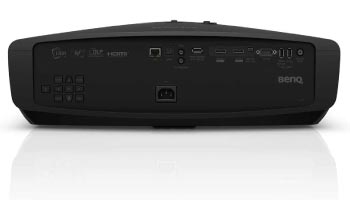
- LAN Ethernet port
- An optical digital output
- A 12-volt trigger
- IR receiver
- A USB 3 media playback ready port
- Two HDMI 2.0b inputs that are HDCP 2.2 compliant will take 4K60p HDR signals.
- A MINI USB power
- RS-232 port
- Two further 2.0 USB ports
- A 3.5mm audio jack.
There is also a menu button plate on the bottom left side should you lose the remote control like me. The remote itself is very easy to use with a lot of buttons.
Performance of BenQ HT5550/W5700
As an SDR projector, the BenQ HT5550/W5700 is one the best home theater projectors in the business giving a lot of units run for their money in the same price range.
Probably the best projector in terms of SDR in the market.
There is not extra brightness available for HDR specular highlights or dynamic range. It is not HDR image capable, but compatible.
You can run HDR content but the image quality will be similar to SDR with no white color gamut accuracy.
It might sound bad, but it manages to produce fantastic SDR images with decent color accuracy. HDR content is also decent thanks to the tone mapping.
Performance is excellent and watchable and of good quality for the price point.
- Excellent SDR image
- Superb image quality with sharpness
- Good black levels
- Very good design
- 100% DCI-P3 cinematic color
- Latest 0.47-inch single-DMD
- A high-quality lens with 2D lens shift & 1.6x big zoom
- 3D capable with fantastic motion
- Budget-friendly
- Performance-oriented
- HDR isn’t that good.
Final Verdict
This BenQ projector is also capable of providing very compelling 3D results with fantastic motion.
It is the best suite of dimmed light rooms with a cinematic experience. It won’t perform any good in ambient light.
Overall, the BenQ HT5550 home theater projector is recommended considering the price tag and decent performance. 8/10 from me.
7. Epson Home Cinema 5050UB – Best projector for Gaming
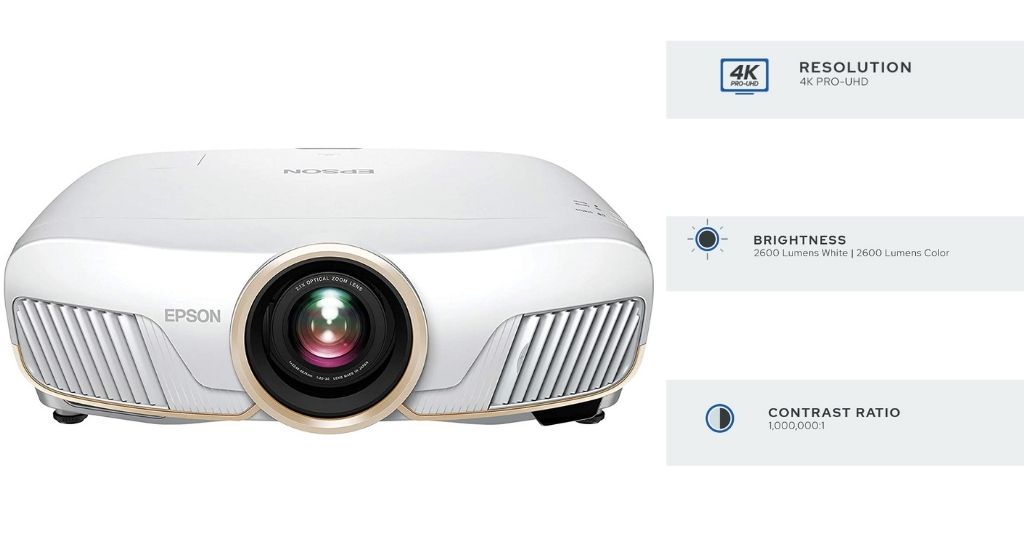
- Advanced pixel-shifting technology
- Advanced digital image processing, 12-bit
- No rainbow effect
- Epson Precision Lens w/Shift technology
- Fantastic brightness
- Loaded with connectivity
- Excellent optics with wide lens shift
- Pinpoint color accuracy and contrast
- CFI technology for smooth motion
- 2 power mode: High, medium, and Eco
- Item dimensions: 17.7 x 20.4 x 7.5 inches
- Item weight: 24.70 pounds
- Resolution: 4K PRO-UHD @60Hz compatible
- Dynamic contrast ratio: 1,000,000: 1
- 2600 lumens with 3500 hours of lifespan
- Full 10-Bit HDR support & HLG support
- Wide color gamut: supports 100% of DCI-P3 color space
- Zoom lens ratio: 2.10: 1
- 3LCD technology
- 1080p 3D support
Epson home cinema 5050UB PRO-UHD Review
Epson home cinema 5050UB PRO-UHD is a 1080p projector with 4K enhancement. After 3 long years since 5040UB came out, the deluxe home theater version of the Epson projector was released back in 2019 which is a step up in many ways.
It is a 2600 lumen projector. That is 100 lumens more than its predecessor which is not much by the sound of it, but in reality, that extra 100 lumens does make a difference when you look at this as a living room piece, and it boosts the 3D performance.
One of the biggest improvements in the Epson home cinema 5050UB home theater projector is the HDR performance.
5040UB did support HDR but it tends to get muddy and a bit dull, it was acceptable on some things and not on others.
With Epson projector 5050UB, the HDR improvements are fantastic, and it is even better in a dedicated bat cave environment with little ambient light. We have also prepared a perfect guide for best epson projectors in 2022 for gaming and home theater, check that out too.
Why choose Epson home cinema 5050UB home theater projector
- Epson projectors are not DLP, they are 3LCD. The major benefit of 3LCD is that they have brighter and more accurate colors without any rainbow effect.
- Not only this unit has crazy brightness, but the black levels are fantastic. Black levels are ultra-black that is why there is “UB†is 5050UB.
- Although the Epson home cinema 5050UB home projector is rated at 2600, with colors being super bright I am pretty much sure it is even brighter than a 3000+ DLP projector.
- 3LCD projectors are also super quiet while working and they consume much less energy than DLP projectors.
- It does have a 15 element lens which is great and makes the picture quality crisp, sharp, and enhanced the 4K.
- It provides huge vertical and horizontal shifts. Put Epson home cinema 5050UB on the corner of your room, and move the image.
- You don’t even need to mount it on the ceiling because it offers excellent vertical shift as well.
- With lens memory, you can create presets. For example, with the touch of a button, the projector will zoom the image out and focus when you are watching sports, and then back to cinemascope when you are back to movies.
- It covers 100% 709 color coverage. 100% DCI-P3. It also has an auto, Iris.
- I would say this projector is made for gaming with less than 30ms of input lag. It is incredibly good for the 4K gaming experience.
Design of Epson home cinema 5050UB projector
This model is the same as far as casing and structure are concerned. The design is extremely beautiful with a centrally mounted lens, IR Sensors, and air vents at the front plate.
The lens has built-in motorized lens covers which are great for a unit under $3k. It does keep dust and aerosols out of the lens.
The top is cleaned and smooth except for a few LED indicators. There is a small door on the right side near the power button. You will find some basic buttons like menu, source, power, and navigation behind that small door.
That small door will keep the dust out. I like these little details in a budget projector. Even the most expensive ones don’t have these little doors or motorized lenses to keep the dust and suspended particles out of the sensitive parts.
As far as weight, dimensions, and design go, it is identical to 5040UB.
Connection and Control
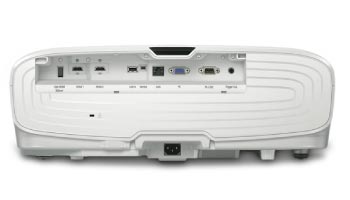
- 2 HDMI 2.0b ports, HDCP 2.2 compliant
- LAN Ethernet port
- USB type-A for power
- A service port
- RS-232c (D-Sub 9-pin)
- A VGA Port
- A 12-volt trigger
- Wireless HDMI 1.4a
The remote is not only backlit, but it has a ton of helpful buttons.
Performance of Epson home cinema 5050UB
Epson home cinema 5050UB is a native 1080p unit that uses pixel shifting to produce 4K just like other DLP 4K projectors.
The difference is, Epson projector uses 2k or 4 million pixels while other DLP machines use 8.3 million pixels on the screen. So the 5050UB is super sharp, but the newer 4K DLP machines are sharper like the BenQ3550.
HDR content is stunningly good. It is not only brighter and crispier than most options at this price tag, but there are so many options for you to adjust the way the HDR looks.
With the ambient light on, the brightness is way better than other high-end models on the market. Overall is this is bright and color accurate.
A lot of times when the image gets real big, you will see those bands of colors start to separate. The 12-bit video processing in Epson home cinema 5050UB prevents that. Everything is smooth even during streaming on a really big screen.
This 4K home projector has one of the best implementations of HDMI-CEC.
- Excellent 4K display after enhancement
- Made for 4K gaming with low input
- Fantastic black levels
- Color accuracy and brightness is top-notch
- Performs better than 2600 lumens
- 3D supported
- Great value for money
- Awesome optics with wide lens shift
- HDR content is almost perfect
- Wireless HDMI integration
- A bit noisy when switched to high power mode
- Not as sharp as DLP 4K projectors
Final Verdict
After a wait of 3 long years, Epson has dropped a bomb in the shape of Epson home cinema 5050UB Home theater projector that is not only exceptionally good for 4K gaming but excellent for a cinematic experience.
I worthy successor to Epson 5040UB. Best home projector for gaming without a shadow of a doubt. 9/10 from me.
8. JVC DLA-NX9 4K D-ILA Home Projector with 8K/e-shift
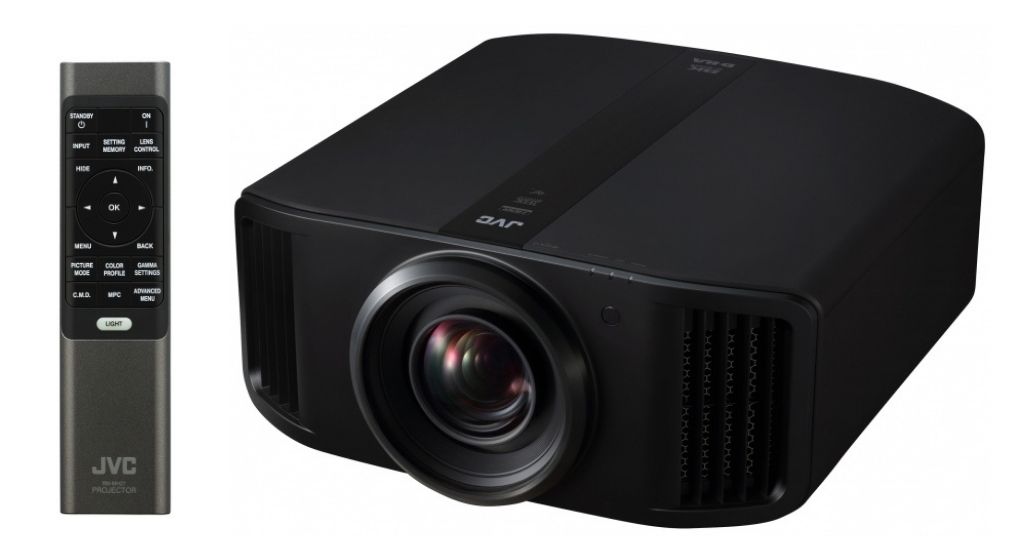
- Realistic and optically clear display
- NSH: 265W high-quality lamp
- Full HD 3D
- Lens shift: Vertical +/-100% and Horizontal +/-43%
- Lamp life: 3000 – 5000 hours (normal/eco)
- Lens: 100mm diameter, all-glass lens. Powered focus. X2 manual zoom.
- 10-bit color processing
- Inputs: HDMI x2 (3D, Deep color/HDCP 2. 2).
- 3D formats: Frame Packing, side by side (half), and top to bottom.
- Outputs: RS-232-C control port, USB service port, LAN Ethernet, and a trigger.
- Item Weight: 48 pounds
- Dimensions: 25.25 x 26.25 x 16.38 inches
- Mounting type: Tabletop
- Model Number: DLA-NX9
- Display resolution: 8192 x 4320 (with 8K/e-shift)
- Dynamic contrast ration: 1,000,000: 1
- HDR10 with auto-tone mapping.
JVC DLA-NX9 4K D-ILA 4K projector Review
This high-end home cinema projector has a monstrous size, crystal clear, sharp, bright, and realistic projection with jaw-dropping details.
JVC claims that the DLA-NX9 home theater is the world’s first 8K/e-shit project capable of projecting at 8192 x 4320 image resolution.
JVC 4K is the flagship native 4k D-ILA best projector which uses 3 times 0.16 inch 4K D-ILA chips. This model is not for the fainted hearts because it is very expensive. But, we have also researched top projectors under $200 for budget people. Check it out.
Why choose the DLA-NX9 home theater projector
- DLA-NX9 is using a very large casing with a huge lens assembly and opening.
- This best home projector uses an all-glass lens in 18 elements 16 groups with an aluminum lens barrel and a 100mm diameter.
- The 100% vertical and 43% horizontal lens shift offers a smooth and flexible installation placement.
- DLA-NX9 sits at top of the ladder due to its game-changer 8k/e-shift technology with the THX certification.
- The 8K/e-shift uses a proprietary high-resolution display tech: which shifts by 0.5 pixels horizontally and vertically to enhance the perceived pixel density up to four times.
- Using e-shift with multi-pixel control converts HD and 4K content to perceived 8K equivalent resolution of 8192 x 4320.
- DLA-NX9 is can’t accept the 8K signals. It can only accept 4k and lower resolutions.
- DLA-NX9’s light output is about 2200 lumens and a contrast of 100,000: 1, and with the advanced Iris control, it can go up to 1,000,000: 1 as a dynamic contrast.
Design of JVC DLA-NX9 Home theater projector
The traditional design is similar to its predecessors but bigger. Two air vents to the right and left side of the plate with a circular, 7 inches, 100mm all-glass lens at the center.
The brushed metal black strip on the top with the logo on it. The overall design is smooth, beautiful, and eye-pleasing.
Connections and Controls of DLA-NX9
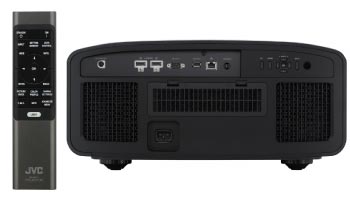
- A 3D sync input,
- Two full bandwidth 18GBps HDMI 2.0 ports compatible with HDCP 2.2 (4K60p 4: 4: 4, 4K60p 4: 2: 2/36-bit, 4K24P 4: 4: 4/36-bit) supported.
- An RS-232-C port,
- LAN network connector,
- A USB service port, and
- A 12-volt trigger.
- A power socket is at the bottom of the casing.
The latest N-series remote control which is shorter in design is included with the package. In case you misplace the remote, there is a manual button panel near the connection at the bottom of the projector.
Performance of the JVC DLA-NX9
In a pitch-black bat cave room, you will get the ultimate performance by DLA-NX9. The dynamic range and contrast performance are one of JVC’s major features. You will get top-notch cinematic content.
In a low light mode, color detailing, and skin tone is realistic with incredible sharpness.
HDR display is a whole different beast. You can’t get that specular highlight and dynamic range, but that doesn’t mean DLA-NX9 is not up to the task.
Thanks to the 3.10 firmware update, DLA-NX9 steps up big time. Just like dynamic tone mapping in HDR TVs, frame adapt does the same thing but for a 4K projector.
Primary colors are represented beautifully with deep blacks, and stunning shadow detailing.
- True Native 4k resolution plus 8K/e-shift
- Game-changing deep blacks
- Amazing shadow details
- Flagship colors and realistic skin tones
- Full HD 3D mode
- High quality all-glass lens
- 1,000,000: 1 dynamic contrast ratio
- Two-time manual zoom, powered focus
- In a bat cave pitch-black room, you will get a realistic projection with flawless detailing.
- Energy efficient
- Easy to install and use.
- Doesn’t accept 8K signals.
- No digital zoom.
Final Verdict
The images are sharp, detailed, and bright with superb screen uniformity as far as focus is concerned.
Color performance is also flawless with full DCI P3 coverage and full volume with the help of dynamic tone mapping.
Overall, DLA-NX9 is the best home theater projector and a true high-end unit. 9.5/10 from me.
Best Home Theater Projector Buying Guide – How to Choose
After spending days into research and data gathering, we have concluded the most function buying for the home theater projector.
Each heading reflects something important that you must read and understand before spending money because a quality home cinema projector can be seriously expensive.
Understand your surrounding and what you can do and what not for better performance and convenience.
Even the best home theater projector needs are adjusted according to your surroundings and home theater atmosphere.
Don’t miss anything. Read the entire guide.
DLP vs LCDÂ vs LCOS – Projector Technology
I will not go too deep into the topic by adding heavy scientific details. I will only highlight some of the easily understandable features. It will help you decide on the projector technology you should get.
- DLP
- LCD
- LCoS
DLP (Digital Light Processing):
What is a DLP projector?
Digital light processing or DLP uses a chip developed by Texas instruments.
A color wheel and microscopic mirrors are combined to direct the light to form images that are true to nature with awesome saturation.
The sealed design of DLP technology slows down gathering into the unit so you don’t need to worry about dust gathering or filter. This ultimately lowers the maintenance cost.
The ultra-fast DLP chip combined with the smaller profile design delivers very smooth and jitter-free images.
DLP color wheel may create a “rainbow effect†as we have seen with most DLP projectors.
They also require more LUMENS in areas with higher ambient light. The spinning color wheel is a bit noisy too.
LCD (liquid-crystal display):
What is an LCD projector?
LCD or liquid crystal projectors used a high-intensity beam that moves through several shifting pixels.
It is a three display instead of one. That is why LCD projectors are also called 3LCD.
The beam of light travels through three LCDs and splits into three colors (red, green, and blue). Later, it is combined into a prism to project a clear and crisp image.
LCD technology uses fixed crystal and there is no movement hence reducing the noise levels.
It is an excellent choice for a home cinema movie experience. LCD projectors are less expensive, offer better color saturation in a high ambient light environment compare to DLP.
It requires very little power to operate, heating levels are also low, and there are no rainbow effects.
LCoS (Liquid crystal on silicon):
What is LCos Projection technology?
Lcos or liquid crystal on silicon technology is a hybrid between LCD and DLP.
The reflective technology of DLP is combined by LCos by blocking the light using crystals just like LCD. This results in deeper blacks and whiter whites.
LCos projectors are known for their extra smooth and film-like image quality.
There are being sold between $3k to whopping $20,000+ offering 1080p to true stunning 4K display.
Brightness – Lumens

Lumen is the measure of brightness coming from the source. In the case of projectors, not all lumens are created equal. There are:
- Color/brightness lumens
- White/brightness lumen
You must look for both before making a purchasing decision because most companies only market white lumens.
It is a bit tricky feature. One company’s 2000 lumens might be another’s 2400 lumens.
So the question is, how many lumens do you need for a home theater projector? The answer depends on your pocket.
If you can afford it, getting a high-end model with high lumen capacity would be a better choice.
But,
Too much brightness creates eye fatigue. Home theater projectors are designed to offer the best performance under little ambient light so a very bright projector is not preferred by most people.
To give a rough idea, 2000 – 26000 lumen projectors like Sony VPL-VW915ES/VW790ES are excellent at producing a bright image with good color contrast and deep blacks.
1000 – 2000 lumen projectors like BenQ HT5550/W5700 or LG HU70LA are also fantastic at producing bright and crisp images.
But you have to understand that in the case of home theaters, brighter projectors are not necessarily preferred.
Other important factors like contrast, black levels, sharpness, and color tones are also considered.
However, if there is a higher level of ambient light in your room, you would need a brighter projector for sure.
Luckily, in our list, we have reviewed some of the brightest projectors on the market which are known for their outstanding picture quality even in the presence of ambient light.
Lighting source
Projectors are powered by one of the following three light sources:
- LED
- UHP (ultra-high power lamps)
- Laser
Projection quality, image quality, price, and durability depend on the type of lighting source being used in a projector.
Lamps and lasers are extremely popular and easily available. LEDs in particular are not so popular because they are not that bright.
Let’s get right into it.
UHP Projectors:
Ultra-high power lamps or UHP are the most oldest and common source of light found in most consumer projectors.
Lamps emit a great green light which is a good thing because green makes up a majority of RGB in video standards.
Lamps in general are less expensive, lightweight, and easy to replace. The replacement UHPs are easy to source and carry around as a backup.
The new lamp makes the projector image looks brand new and the initial purchasing cost is low.
There are some drawbacks of lamps as well. The lamp takes time to heat up and show an image. They can be a bit noisy too because cooling fans work to prevent overheating.
Over time, lamps become dimmer. Color profiles shift over their lifespan. The color balance fades, and eventually, the picture quality becomes greyish with a little performance.
Lamp-based HD projectors are a very good choice for personal and professional use because they offer high lumens and better picture quality.
- Inexpensive to implement
- They are very bright
- Reliable
- Offers good picture quality
- Shorter lifespan
- Expensive in most cases
- Super energy inefficient
- They get hot
- Needs time to warm up and cool down
Laser projectors:
Laser projectors use high-frequency laser beams as a light source. This is a newer technology and gaining fame day by day.
Lasers offer very good brightness, lower maintenance cost, and improved contrast and color compare to similar lamp-based models.
They are a very good choice for heavy applications and all-day use due to their low overheating ability.
They also offer very easy and user-friendly installation. There is some model that can be mounted at any point of a 360-degree radius.
Laser projectors turn ON/OFF instantly. They are silent at work as well because fan noise is minimum as they don’t get hot easily.
The range of colors that is called color volume can be greater than UHP sources and colors are stable as well. The laser model can also be an ultra-short-throw projector. Speaking of Ultra-short throw, check out the top 6 UST models in 2022Â for gaming and office. If you want to learn about short throw models in general, read of short-throw guide.
Laser projectors are comparatively very expensive. They are a little less portable compare to UHP-based projectors.
These models are mostly used for high-end home cinema applications or any professional event.
A high-end unit like VPL-VW915ES/VW790ESÂ is using laser beam technology that is why it is one of the best home theater projectors in the business.
So technology is getting cheaper and popular by the day.
- Highly energy efficient
- Longer lifespan
- High brightness
- Wide color spectrum
- No replacement of the bulb
- Extremely expensive in most cases
Led Projector:
LED projectors use a light-emitting diode to project content on a flat screen.
LED projectors are great. They offer very good picture quality and they take no time to start, but they are a bit dim.
The best-LED projector can be very appealing due to its lifespan of 25,000 -30,000 hours. Virtually zero maintenance cost, never have to replace them, but they are not that bright.
A $2000 laser or lamp-based projector will always be brighter than a $2000 LED-based projector.
Despite all that, the LED projector does offer spectacular color and contrast performance, and they are budget-friendly too. Speaking of budget, check quora for further home theater knowledge.
Models like LG HU70LA are using LED lighting sources and LG HU70LA is considered one of the best home theater projectors in the market.
- Long lifespan
- Takes no time to start
- Doesn’t get hot easily
- Virtually zero maintenance cost
- Fantastic color control
- Quieter operation
- Not as bright as lamp or laser projectors
- High-end models don’t use an LED lighting source
Ambient light
The whole concept of a home theater projector is a bat cave environment with little to no ambient light present. Only then one can have a true cinematic experience.
Firstly, you need to estimate how much outside light is penetrating your room.
If there is a lot of sunlight even with the curtains drawn and windows shut, you will need a movie projector that works well in the presence of ambient light (more lumens).
Epson home cinema 5050UB and Optoma UHD50X home theater projector work exceptionally well even in ambient light.
Even if you purchase a high-end business projector that works well in the ambient light, the contrast will be lower and the image will always be washed out a bit.
Let me give you an example of how much lumens do you need in the presence of ambient light:
Depending on the quality of the projector and how well the picture can be displayed in the ambient light, Lumens can vary. This is a rough estimation of a general home theater projector.
- 1500 – 2200 LUMENS if your home theater has a bat cave environment (completely dark)
- 2200 – 3000 LUMENS if your home theater has some presence of ambient light.
- 3000 – 4500 LUMENS if your home theater is huge and there is plenty of sunlight.
My advice:
It doesn’t matter whether your project can display bright and crisp images even in the sunlight, the whole concept of a home movie projector is to experience true cinematic content.
For that, you would need a room where sunlight penetration is minimal to zero.
The throw ratio of the projector
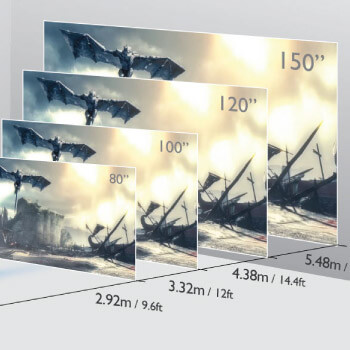
It is the ratio between throw distance and the width of the image. Throw distance is the distance between your projector, and the wall/screen you’re projecting in.
If a projector is projecting a very big image by keeping it closer to the projection screen, then it is a short-throw projector.
If a projector requires some distance to cast an image on the screen, then that projector is called a long-throw projector.
Short throw projectors are usually used in the small conference room whereas long-throw projectors are mostly used in large venues such as classrooms.
How do I know if the projector is a short-throw projector, ultra-short-throw projector, or long-throw projector?
The throw ratio is mentioned in the manual.
- 6 – 0.8 throw ratio= short-throw projector
- 4 or less: ultra-short projector
- If it is not less than 1, then it is a long-throw.
In the case of a home theater, it depends on the size contour of your room.
To give you a rough idea of the distance:
- From a 5.5m throw distance, the image size will be roughly 220cm.
- Form 5m throw distance, the image size will be 200cm.
That also depends on the type of projector, projector manufacture, and lighting source.
So ultimately, you need to determine your home theater size.
Resolution – 4K or 1080p
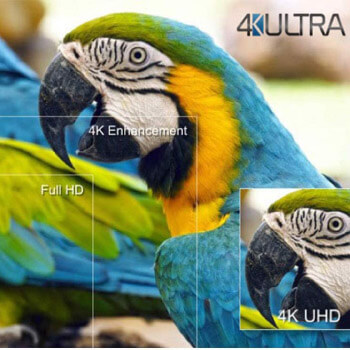
Probably the most important aspect of a projector is the resolution. Resolution determines how sharp the image looks while casting it on a big screen.
In simple words, resolution refers to the number of pixels on the imaging chip when measured vertically and horizontally.
The more pixels on a chip, the better the image quality will be.
Most of the home theater projectors are 1080p (1920 x 1080p pixels) and they work great, but the expensive ones or the ones that use pixel-shifting technology to enhance the resolution up to 4K offer stunning image quality.
A normal viewer will never spot a difference between 1080p projection and the pricy 4K projection, but for a proper home theater setup, I would suggest a 4K projector like  JVC DLA-NX5 4K D-ILA Projector, Optoma UHD50X True 4K UHD offers stunning 4K display at an affordable price tag.
Contrast ratio
Contrast ratio means the ratio of the lumens of the whites to that of the blacks while portraying them on the screen.
In simple words, how white the whites are, and black the black levels are.
The higher the contrast ratio, the higher will be the depth in the scenes and the blacks will also look much livelier.
Contrast ratio doesn’t play a big role during the purchase of a general-purpose projector, but as far as a home theater projector is concerned, a good contrast ratio is essential.
Greater ambient light can nullify the difference in contrast ratio between projectors. It is crucial to check the contrast ratio for a home theater projector.
Units like JVC DLA-NX5, Optoma 1080p HDR, Epson home cinema 5050UB, and JVC DLA-NX9 offer pin-sharp contrast ratio for excellent picture quality in a bat cave environment.
Connections and control
Sufficient ports and connectivity are extremely important because nowadays home theater projectors are not only used to the cinematic experience, but gaming on 4K projectors is becoming a trend.
If you connect a gaming console, blue-ray player, or an HD cable box to your home theater unit, the following connections are considered standard in projectors between $1500 – $3000 price tag.
- A 3D sync input,
- Two full-bandwidth 18GBps HDMI 2.0 ports are compatible with HDCP 2.2 compliance.
- An RS-232-C port,
- LAN network connector,
- A USB service port, and
- A 12-volt trigger.
- A power socket is at the bottom of the casing
Zoom – Motorized Lens
It means motorized zoom, motorized focus, or both. Zoom capability is a must in all modern projectors. Adjusting the screen is frustrating without zoom.
If your projector has preset settings then you can fill the screen with a touch button without adjusting the zoom again and again.
It means, you can fill the screen to a wider size for movies, and you can zoom down to adjust the screen for TV at the same time.
Low input lag for gaming
The gaming industry can be brutal when it comes to resolution, picture quality, and input because hardcore gamers can spot even the tiniest flaw.
Gaming on a projector has to gain popularity throughout the gaming community.
With 4K resolution and stunning black details, gaming on a quality projector can be awesome.
Gaming Projectors like Optoma UHD50X, VPL-VW915ES/VW790ES, and Epson home cinema 5050UB are known flawless experiences with low input lag and stunning picture quality.
Optoma UHD50X offers a 24 Hz refresh rate at 1080p and low input lag that is it is considered the best gaming projector at an affordable price tag.
3D Compatibility

3D is not a huge thing anymore because you will be cutting your brightness in half if you still want 3D in a home theater projector.
But,
Many quality home cinema projectors are 3D-ready. It means you will be hooking your 3D projector to a 3D-compatible device for a true HD 3D experience.
Other models like BenQ HT3550/W2700, DLA-NX9, and JVC DLA-NX5Â also support 3D.
Some models have built-in 3D capability while others require a 3D emitter.
HDR performance
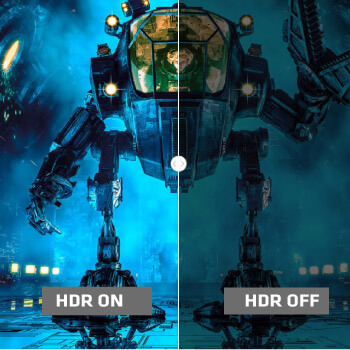
High dynamic range or HDR is now a thing in projectors as well. While the HDR performance increases from lower-end to higher-end projectors, but it can never match the HDR content of a TV.
Projectors are trying to master the HDR tech but the issues like limited brightness, dimming, limited color reproduction, and low contrast ratios limit the HDR performance on a projector.
Without diving deep into the topic, we gathered a list of models that are pretty much good at HDR performance.
JVC DLA-NX5 uses HDR10 which is compatible with auto-tone mapping to improve the HDR playback to balance out the image while retaining tiny shadows and highlights.
Optoma UHD50X also has a good HDR performance with HLG support.
Sony VPL VW295ES doesn’t only have HDR01/HLG compatibility, but its HDR reference mode is used to retain the creator’s intent.
Lens shift – keystone correction
Projector keystone correction or lens shift means moving the projection left or right, up or down while keeping the projector stationary.
In simple words, it is repositioning of the projection according to your projection screen size
It may not seem a big deal, but trust me it is a super user-friendly feature.
Instead of repositioning your movie projector manually, keystone correction helps you to position the projector off-center about your screen.
Models like JVC DLA-NX5 offer a Lens shift of +/-80% Vertical. +/-34% Horizontal, Sony VPL VW295ES offers a Lens shift of Vertical: +80%, -85%. Horizontal: +/-31% and many other projectors like BenQ HT3550/W2700, VPL-VW915ES/VW790ES, and DLA-NX9 are known for their excellent lens shift.
I am a huge fan of models that allow huge vertical and horizontal lens shifts. It is a lifesaver in the home theaters where projection is on the far right, or far left.
The best home theater projectors have massive lens shifts. Luckily we have covered all such models in our list.
Where to place a home theater projector
Your placement may be limit the options of projector that you can buy, as some might not fit where you want to be.
If you are going for the most affordable single-chip DLP projectors, you would need a big enough and a perfect-sized screen for that because those types of projectors offer little to zero lens shift.
It means you will have to manually adjust the projector’s position.
These projectors have an upward through so they require either ceiling or table mounting.
You will need to check the lens shift before purchasing the single-chip DLP models.
LCos and LCD projectors are excellent as far as lens shift is concerned.
If it is short-throw, then it is fine, but for a regular projector, you need to determine the distance because most projectors have a limited zoom lens.
My projector has a great zoom lens but I normally don’t rely on that.
My advice would be to use the distance calculator on the manufacturer’s website.
Frequently Asked Questions (FAQs)
Q: What is a good home theater projector?
- EDITOR’S CHOICE: JVC DLA-NX5
- BEST FOR GAMING: Optoma UHD50X
- LATEST WEBOS: LG HU70LA 4K UHD
- BEST UNDER $5K: Sony VPL-VW295ES
- BEST UNDER $1500: BenQ HT3550 4K
- BEST SDR: BenQ HT5550
- BEST FOR GAMING: Epson 5050UB
- HIGH-END: JVC DLA-NX9
Q: How much does a home theater cost?
Depending on chip technology, lighting source, manufacturers, and picture quality, the price can range from $500 – $20,000. To give a rough idea:
- High-end LCos or Laser projectors: $5000 – $15,000.
- Native 4K projectors: $3000 – $8000
- Affordable projectors: $1500 – $3000
Q: Which is better TV, or a home theater projector?
In terms of maintenance, brightness, contrast, space, and audio quality, TV beats the projector all day long. But, in terms of value for money, screen size, resolution, and portability, projectors should be your choice if your budget is between $1k – $1.5.
Q: Can a bedsheet be used as a projector screen?
As long as you are hanging it properly without any folds or wrinkles, any piece of white cloth would do the trick.
What can be used instead of a projector screen?
Q: Depending on your budget:
- Plain wall
- Simple white cloth without folds or wrinkles
- Shades
- Wrapping paper
- Projector screen paint.
Q: Can we use a black sheet as a projector screen?
In a room where ambient light is dominant, a black screen will give you a much sharper image with decent black levels compared to a white screen in a similar room.
Q: Can projectors work on grey walls too?
Yes. Grey and black walls are particularly good if there is plenty of ambient light present in the home theater.
Q: Which is a better projector LED or LCD?
- Very good color brightness
- Pulsating 3D projection without image ghosting
- Energy-efficient and quieter.
- Brighter outputs and sharp images.
- Lower heating levels
- Less expensive
- No rainbow effects
- Regular filter maintenance
- Visible image pixelation compared to DLP
- Long lifespan
- Takes no time to start
- Doesn’t get hot easily
- Virtually zero maintenance cost
- Fantastic color control
- Quieter operation
- Not as bright as lamp or laser projectors
- High-end models don’t use an LED lighting source
Q: Is JVC-NX5 laser, lamp, LED projector?
It has a lamp.
Q: What is the height of the JVC-NX5 without the feet?
8 ¼ inches approximately.
Q: Is Optoma UHD50XÂ 3D capable?
Yes. You would need to purchase DLP glasses separately.
Q: How much does it cost to replace a projector bulb?
Depending on the projector, bulbs are between 400 – 550 dollars. There are some below $300 as well.
Q: How many years, does a projector bulb last?
Depending on your usage and maintenance, 1500 – 2200 hours is the maximum life capacity of most projector lamps.
Q: Do all projectors use a lot of electricity?
Depending on your usage, $0.04 per hour is the average electricity consumption by a projector, but that can change if you are using an efficient LED, or LASER projector. Overall, projectors don’t consume a lot of energy.
Q: How long can you leave a projector ON?
As long as it is operating under normal circumstances without dust, proper ventilation, and normal room temperature, you can leave it on 24/7.
Q: How do I keep the projector cool?
There should be proper ventilation in your home theater. Change the air filters regularly, and place a cooling pad under them.
Q: Can a projector damage your eyes?
The laser would hurt your eyes without any doubt if you look directly at it for a prolonged period. But as far as the display goes, it won’t do any damage.
Q: Is the 4K projector any good?
True 4K resolution will give you a stunning display of sharpness, black levels, and details. It is worth it.
Q:Â How many volts does a projector use?
60 volts is the standard. May vary a bit.
Q: Are projectors loud?
Not all projectors are loud. Yeah, there are models that are exceptionally noisy, but models like LG HU70LA and BenQ HT5550Â are silent while working.






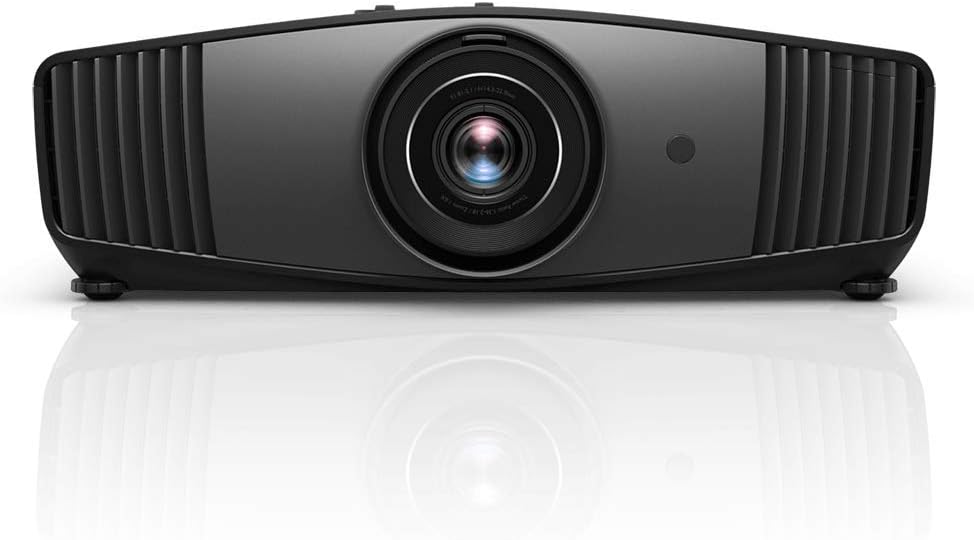


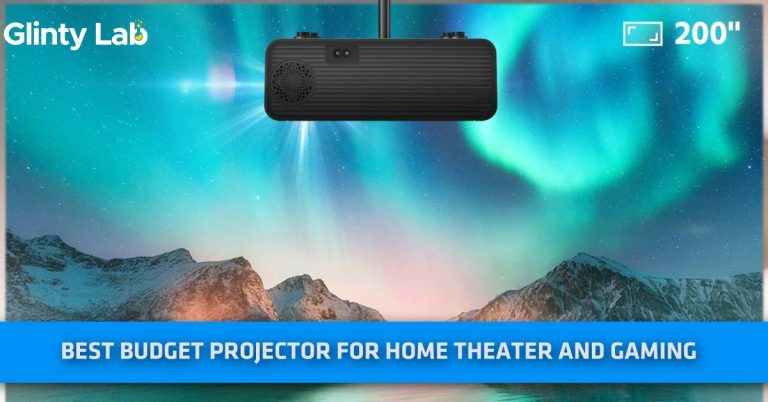
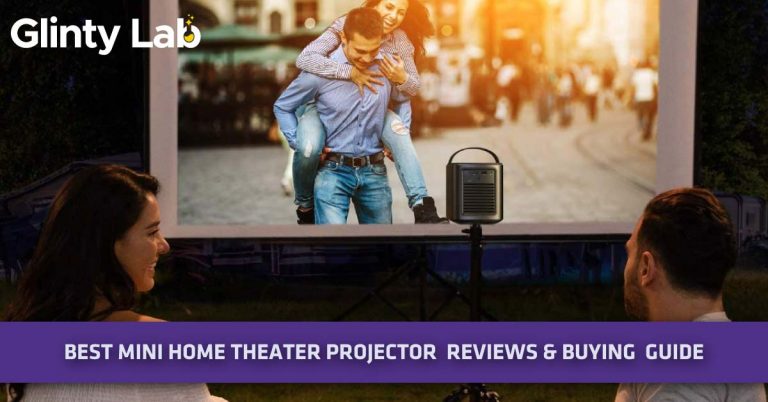
![Top 7 Best Epson Projectors of 2024 – [Reviews & Buying Guide]](https://glintylab.com/wp-content/uploads/2021/03/best-epson-projectors-768x402.jpg)
